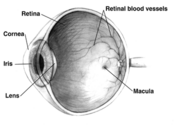Richer S, Stiles W, Statkute L, et al. Optometry 2004:75:216-230.
BACKGROUND: Age-related macular degeneration (ARMD) is the leading cause of vision loss in aging Western societies. The objective of the lutein antioxidant supplementation trial (LAST) is to determine whether nutritional supplementation with lutein or lutein together with antioxidants, vitamins, and minerals, improves visual function and symptoms in atrophic ARMD. METHODS: The study was a prospective, 12-month, randomized, double-masked, placebo-controlled trial conducted at an urban midwestern Veterans Administration Hospital from August 1999 to May 2001. Ninety patients with atrophic ARMD were referred by ophthalmologists at two Chicago-area veterans medical facilities. Patients in Group 1 received lutein 10 mg (L): in Group 2, a lutein 10 mg/antioxidants/vitamins and minerals broad spectrum supplementation formula (L/A): and in Group 3, a maltodextrin placebo (P) over 12 months. RESULTS: In Groups 1 L and 2 L/ A, mean eye macular pigment optical density increased approximately 0.09 log units from baseline, Snellen equivalent visual acuity improved 5.4 letters for Gronp 1 L and 3.5 letters for Group 2 L/A, and contrast sensitivity improved. There was a net subjective improvement in Amsler grid in Group 1 L. VFO-14 questionnaires concerning subjective glare recovery were nearly significant at 4 months for Group 2 L/A. Patients who received the placebo (Group 3) had no significant changes in any of the measured findings. CONCLUSION: In this study, visual function is improved with lutein alone or lutein together with other nutrients. Further studies are needed with more patients, of both genders, and for Ringer periods of time to assess long-term effects of lutein or lutein together with a broad spectrum of antioxidants, vitamins, and minerals in the treatment of atrophic age-related macular degeneration.
COPYRIGHT 2004 Thorne Research Inc.
COPYRIGHT 2004 Gale Group




